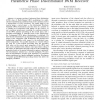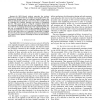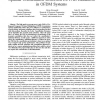PIMRC
2008
IEEE
14 years 6 months ago
2008
IEEE
—In wireless sensor networks, in-network aggregation is the process of compressing locally the data gathered by the sensor nodes, so that only the compressed data travel across s...
PIMRC
2008
IEEE
14 years 6 months ago
2008
IEEE
— We consider the problem of rate allocation in a fading Gaussian multiple-access channel with fixed transmission powers. The goal is to maximize a general concave utility funct...
PIMRC
2008
IEEE
14 years 6 months ago
2008
IEEE
—A constant envelope Continuous Phase Modulation (CPM) class of Multi-Channel (MC) modulations for multiantenna transmitters is considered. Each receive antenna receives a superp...
PIMRC
2008
IEEE
14 years 6 months ago
2008
IEEE
—In 802.11-based wireless networks the stations (STAs) are associated with the available access points (APs) and communicate through them. In traditional handoff schemes the STAs...
PIMRC
2008
IEEE
14 years 6 months ago
2008
IEEE
—Dense deployments of hybrid WLANs result in high levels of interference and low end-user throughput. Many frequency allocation mechanisms for WLANs have been proposed by a large...
PIMRC
2008
IEEE
14 years 6 months ago
2008
IEEE
Abstract— Two-way relaying, which enables bidirectional simultaneous data transmission between two nodes, is an efficient means to reduce the spectral efficiency loss observed ...
PIMRC
2008
IEEE
14 years 6 months ago
2008
IEEE
Abstract—The high peak-to-average-power ratio (PAR) of Orthogonal Frequency Division Multiplexing (OFDM) transmission systems significantly reduces the power efficiency or perf...
PIMRC
2008
IEEE
14 years 6 months ago
2008
IEEE
—WiMAX mesh mode, recently standardized, enables direct communications between subscriber stations without referring to the base station (BS). It can be a great solution for prov...
PIMRC
2008
IEEE
14 years 6 months ago
2008
IEEE
—Key factors of indoor NLoS radio channels are examined, namely the number of channel taps, the mean delay, the RMS delay spread and the channel gain. We analyze wideband (2-11 G...
PIMRC
2008
IEEE
14 years 6 months ago
2008
IEEE
— Future mobile communications systems demand for higher data rates and service quality compared to state-of-the-art systems. One way to achieve this ambitious goal is to use rel...



